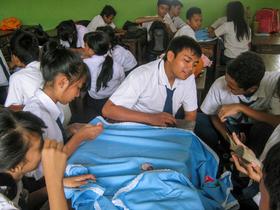For the 2025-26 school year, there is 1 public school serving 137 students in New Salem, MA.
The top-ranked public school in New Salem, MA is Swift River. Overall testing rank is based on a school's combined math and reading proficiency test score ranking.
New Salem, MA public school have an average math proficiency score of 37% (versus the Massachusetts public school average of 43%), and reading proficiency score of 32% (versus the 45% statewide average). Schools in New Salem have an average ranking of 3/10, which is in the bottom 50% of Massachusetts public schools.
Minority enrollment is 12% of the student body (majority Hispanic), which is less than the Massachusetts public school average of 47% (majority Hispanic).
Best Public Schools in New Salem, MA (2025-26)
School
(Math and Reading Proficiency)
(Math and Reading Proficiency)
Location
Quick Facts
Rank: #11.
Swift River
(Math: 35-39% | Reading: 30-34%)
Rank:
Rank:
4/
Bottom 50%10
201 Wendell Rd
New Salem, MA 01355
(978) 544-6926
New Salem, MA 01355
(978) 544-6926
Gr: PK-6 | 137 students Student-teacher ratio: 9:1 Minority enrollment: 12%
Frequently Asked Questions
What are the top-ranked public schools in New Salem, MA?
The top-ranked public schools in New Salem, MA include Swift River.
How many public schools are located in New Salem?
1 public schools are located in New Salem.
What is the racial composition of students in New Salem?
New Salem public schools minority enrollment is 12% of the student body (majority Hispanic), which is less than the Massachusetts public schools average of 47% (majority Hispanic).
Recent Articles

Charter Schools vs Public Schools 2025: Key Differences & Trends
Explore updated 2025 insights comparing charter schools vs public schools, enrollment, academic outcomes, funding, and real-world examples for families and educators.

Are Public Schools Ready for the 21st Century? 2025 Update
Explore 2025 insights on whether public schools are ready for the 21st century, covering performance, technology, equity, funding, and future-ready learning.

Public School Open House & Enrollment Season Guide
A parent-focused guide to the public school open house and enrollment season, with expert questions, timelines, and decision tips.
